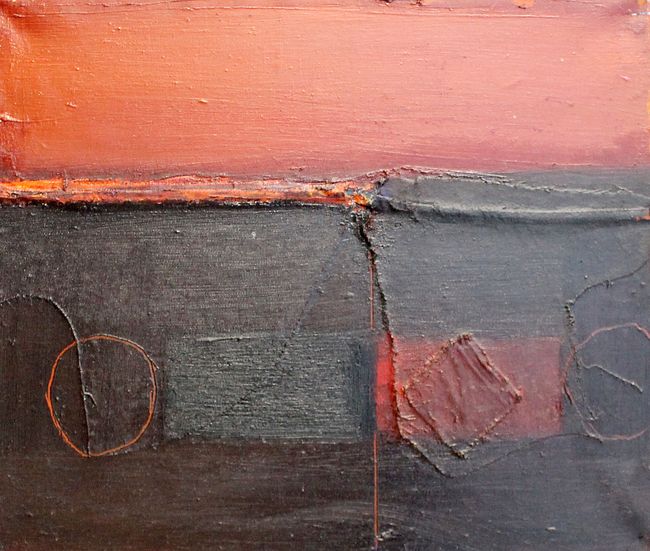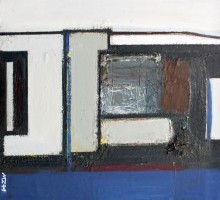The exhibit “Picturesque Preserve: Golden Period” shows for the first time the works created in 1990-99 and now kept in private collections.
The exposition creates a very strange impression. I thought I would begin the story by saying that the exhibition hall of the “Golden Section” auction house has turned, quietly and without too much hype and pomp, into one of Kyiv’s leading galleries in the past few days, where you can always see the best of contemporary Ukrainian art.
The art group “Picturesque Preserve” (1991-95) included Tiberii Silvashi, Oleksandr Zhyvotkov, Marko Heiko, Anatolii Kryvolap, and Mykola Kryvenko, but, as a matter of fact, lots of then young Ukrainian artists went through the “woods of the preserve” with Silvashi at the head and Sedniv plen-air sessions. The pictures, life stories, and even interviews of the “preserve people” have long been objects of citation. Yet, according to Stanislav Skoryk, a curator (together with Silvashi) of the “Golden Section” exhibit, almost 30 canvases of the five non-figurative masters represent a full “profile” of the group in the 1990s for the first time after the “anniversary” exhibit “Landscape of the Picturesque Preserve” at the National Art Museum in 2002.
When you write about Silvashi, Zhyvotkov, Kryvolap, paintbrush wizard Heiko, and Kryvenko, you cannot help recalling their search for color and new picturesqueness as a basis of the life philosophy of the “magnificent five” Kyiv abstractionists. (In reality, there were eight of them at first, but it no longer matters.) This writer must quote “A Description of the Sky above the Preserve,” a “policy article” by Silvashi himself. This text is reproduced in two catalogs of this art association’s exhibits – the current “golden” exposition and the previous one held in 2008 at Shcherbenko Art Center.

“Looking back, we can say that the program ‘Picturesque Preserve’ was a program of neo-formalism: 1) self-sufficiency of art; 2) art as a technique; 3) faith in the uniqueness of artistic experience. Hence it is clear that the object of art is art itself. The object of painting is painting itself, the ‘creation of it.’ In the early 1990s, when the very idea of ‘art’ was being vulgarized and simplified, it was important to keep its limits.”
After all, I needn’t have mentioned the all-out craze, which almost looked like religious worship, for “trans-avant-garde” in Kyiv in the 1990s. Undoubtedly, this factor, and not only information about Miro and Pollock which was leaking through the USSR’s “iron curtain,” influenced “Preserve” at the time. The apotheosis of this was the visit of the Italian curator and critic Achille Bonito Oliva, the “father” of the term (and the movement) “trans-avant-garde,” to Ukraine in 1996. Unfortunately, soon after this historic visit both nonfigurative art and Bonito Oliva went out of fashion in Ukraine, while “Picturesque Preserve” participants carved out an art career singly. One of them, Kryvolap, is called today “the most expensive artist of Ukraine” and another, Zhyvotkov, is considered a recluse, almost an alchemist of painting, and Silvashi is referred to as a “living classic.” He seems to be the only one who is not tired of reminding us of the “preserve’s” “golden” time.
Art theorist Borys Hrois wrote in the book Down the Stream, among other things, about how contemporary art changes under the influence of the internet. It is the worldwide web that has become the main method of presenting and archiving any phenomena of culture (“I must say there is no art and literature in the internet. It only has information about art and literature, as well as about other fields of human activities”). To make the conversation about the new “Picturesque Preserve” exhibit, the first in the past ten years, more substantial, I also decided to find out what materials on the art association are accessible in the internet today. Here’s the result: except for a small article by Olha Petrova in the Encyclopedia of Contemporary Ukraine and the catalog of the 2008 exhibit on Shcherbenko Art Center’s website, there was no information at all about the “Picturesque Preserve” in the web – if we don’t take into account some scattered eyewitness evidence, in particular from Silvashi. If the history of Ukrainian art in the 1990s had emerged in good time, what would we know about it now? And what are we going to learn about the 1990s a few years later? Perhaps only the fact that time is merciless even to the best in art.
The exhibit will remain open until April 14.







